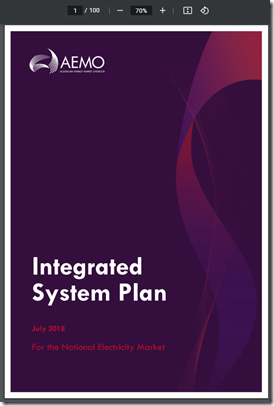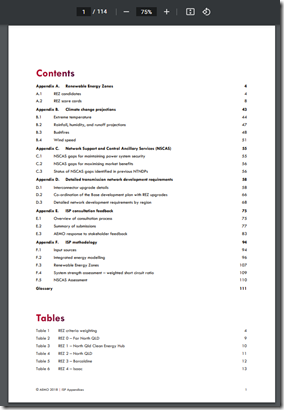This is a back-dated article – posted as something that will be referenced in future.
On 17th July 2018 (as noted in this Media Release at the time), the AEMO released its first Integrated System Plan for the National Electricity Market.
(A) Triggered by the Finkel Review
The ISP built on the work of AEMO’s 2018 National Transmission Network Development Plan (NTNDP) – but went beyond that, in response to the Finkel Review (specifically pertaining to the need for a strategic national plan).
The Finkel Review noted (p3):
“We observed that every country or jurisdiction has a unique electricity system. The one thing most have in common is a strategic plan to preserve energy security and affordability while transitioning to a lower emissions future.
In Australia, we held public and private consultations in every region of the National Electricity Market. We received 390 written submissions. Our consultations included large industrial users such as copper mines, small businesses such as meatworks, consumer and business representatives, market participants, regulators, government departments and your Energy Ministers.
The overwhelming message was the call for Australia to adopt a single, nationally agreed plan to manage the transition to a lower emissions economy. Stakeholders argued that business as usual is not an option. Policy reversals and piecemeal government interventions undermine investor confidence”
The Finkel Review also noted (p124) that:
“Stakeholders have identified a range of whole-of-system benefits that can be realised through greater strategic planning of transmission infrastructure including:
• Creating more options for reliability through the development of a diverse mix of large-scale generation capacity in a range of locations through the grid, including the development of new renewable energy zones.
• By enabling the connection of large-scale renewables and large-scale backup generation and storage, such as gas, grid-scale batteries and pumped hydro, the transmission system can be a critical enabler of significant emissions reductions.
• Ensuring the transmission system is able to contribute to the preservation of network security and stability, including through inter-regional provision of security services.
• Ensuring reactive power control, and in future by procuring necessary inertia and fast frequency response.
• Increasing affordability by ensuring consumers are able to access the benefits of a competitive wholesale market”
(B) Where to download the 2018 ISP
The 2018 ISP consisted of two main PDF documents – a 100-page main report, and 112-pages of Appendices:
|
100-page main report |
112-page appendix |
|
Here’s the main report:
|
Here are appendices: |
Further information about the 2018 ISP is currently here on the AEMO website (including the link to this Interactive Map).
(C) Media coverage of, and commentary about, the 2018 ISP
As this is a back-dated article, I am not going to back-fill this detail (at least at this point).




Leave a comment